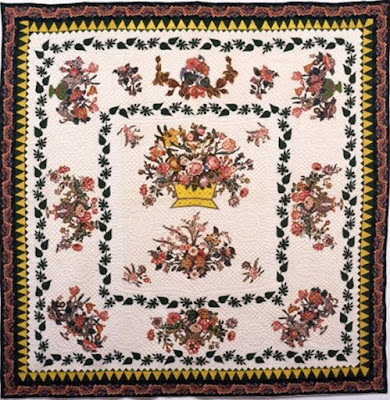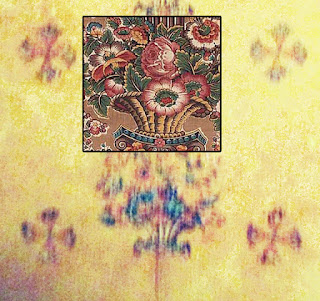Quilt attributed to Catherine Garnhart, 1849
DAR Museum, Gift of the Markey family.
Quilt attributed to Catherine Garnhart
Collection of the DAR Museum
We begin with a popular floral, this iris-like bloom in a quilt that the family thought appliqued about 1825 but not quilted until 1846.
Two views of that flower appear in a print dated 1830-1840 in the collection of the Victoria & Albert Museum. Terry Terrell recognized it a a Mexican Shell Flower. See Terry's website with information on this print: http://www.flowersonchintz.com/Flower%20-%20Tigridia.htm
Shellflowers alternate with a bouquet featuring a white calla lily and a cluster of purple auricula (primroses).
Block dated 1842
Jeana Kimball has a single block dated 1844.
See a post about this floral chintz here:
International Quilt Study Center & Museum, dated 1842-1844
This chintz sampler has the calla bouquet in each corner with the Mexican shell flower adjacent here.
Mary Rooker Norris's 1846 quilt
Collection of the DAR Museum.
The print is chopped up in the corners of the dedication block here.
The print is chopped up in the corners of the dedication block here.
The calla in the vase in the quilt attributed to Catherine Garnhart at the top of the page seems to have been printed in a different colorway---or else it's faded so much we can't tell if its the same lily. The footed vase or urn is also a popular chintz. Style characteristics are a white highlight in the center and a red peplum (is that the right word?) the curlicue at the top of the foot.
A different colorway in another quilt attributed to Catherine Garnhart in the DAR collection (see the top of the page).
This vase with the red curlicue under the bowl appears four times in this quilt.
But in the corners the only part used was the foot and the red curlicue.
Below the eagle in this one
Same print in other groups of appliqued bedcovers:
Chintz applique with a medallion format at the International
Quilt Study Center & Museum
https://www.quiltstudy.org/quilt/19970070253
Sunburst quilt passed down in the Darnall family
Maryland Historical Society
IQSCM has two chintz medallions with the same center. I found a third in William Rush Dunton's book on Baltimore quilts (Plate 67 right). None of the quilts with this vase is date-inscribed and the estimated dates range from 1820-1850.
We see the vase in quilts but I've been unable to find yardage with this particular floral arrangement in that footed vase. I'm looking for a vase with a few carnations and some trailing stems.
Dunton was a bit too early in dating the chintz applique in plate 67 as 1825. I'd guess the print was available in the U.S. after 1830. Do note at the top of the page: the Garnhart family story that the top was quilted in 1846. This seems a more likely date for the applique rather than their 1825 estimate based on a child's birthdate.
Dunton wasn't all that accurate on dates. He was dealing with family stories and he had a limited view in the 1940s. In the caption for another chintz medallion he hedges his bets: "Said to have been pieced in 1733 by Mrs. Tibbs."
About 100 years off.
We see the same wicker basket in a Garnhart quilt, one
of a pair along the sides of the composition
The basket is cut from a pillar print---
yardage photo from Boston's Museum of Fine Arts collection.
IQSCM collection
Again I've got photos of several chintz applique quilts using this print
but none with a date.
This intriguing quilt uses 20 of the pillar print capitals as vases,
but the seamstress must have had only a narrow (and very long) strip
as she assembled each of those arrangements from two or three chintzes.
I'd bet this is a Maryland quilt---the reverse appliqued feather vines,
the central star....
She pieced two other florals to her narrow strip.
Another from IQSCM with the pillar in the corners
Pook & Pook Auction, the Bennet family in Maryland
From a 1981 Quilt Engagement Calendar
America Hurrah the dealer
Rebecca Everingham Wadley
From the Georgia project book Georgia Quilts
From the Wilton House Museum collection in
Richmond, Virginia, the basket in the lower center.
Another pillar print--this one with a bird of paradise or pheasant
and some fruit.
Detail of the Elizabeth Welsh quilt
Brooklyn Museum
The print is trimmed and appliqued without any other flourishes
in the corners of the Welsh quilt.
Yardage in whole-chintz coloring
The Winterthur Museum has a couple of pieces. They date the fabric to 1835.
There are two capitals, one in the pillar and one at an angle below the bird
In this Garnhart group quilt the top capital becomes a container.
Four of the images in this Garnhart family quilt, are cut from the fruit and pillar print.
And one last pillar print,
the chintz in the border of two or three of the Garnhart group.
Also seen in the border of this block style Irish-chain.
No date but 1835-1860 I'd guess.
I could go on with more prints, but the point is made I hope:
The common fabrics the Garnhart quilts share with other bedcovers date most logically from 1830 to 1850. Although some of the grandchildren who handed down the quilts were born in the 1820s, it is unlikely the quilts were given at their births, information passed on in family stories.A major source for the family lore is the 1919 biographical manuscript by great-grandson Frederick Gibson who was 4 years old when Catherine Garnhart died. That manuscript is in the D.A.R. Library.
Tomorrow: Techniques








































No comments:
Post a Comment